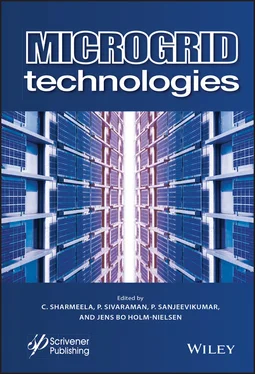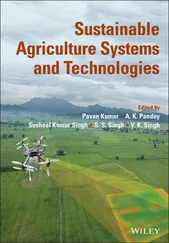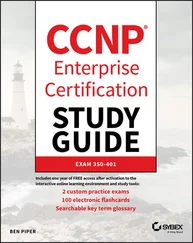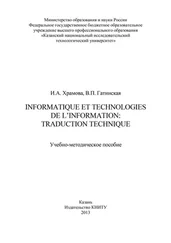12 Chapter 12Figure 12.1 Block diagram of SECS.Figure 12.2 Equivalent diagram of supply system having different loads.Figure 12.3 Phase-A (a) bus voltage with linear load, (b) bus voltage with non-l...Figure 12.4 Voltage spectrums with (a) linear load and (b) non-linear load and C...Figure 12.5 Equivalent diagram of capacitor bank attached in parallel with laggi...Figure 12.6 (a) Voltages and (b) currents with and without capacitor bank.Figure 12.7 Equivalent diagram of SEPQ.Figure 12.8 Flow chart for control of SECS in D-STATCOM mode.Figure 12.9 (a) SEPQ current for mode-1.Figure 12.10 (a) DC bus voltage, (b) active power of SEPQ, load and grid, and (c...Figure 12.11 (a) SEPQ current for mode-2.Figure 12.12 Grid current spectrum (a) without SEPQ and (b) with SEPQ.Figure 12.13 (a) DC bus voltage, (b) active power of SEPQ, load and grid, and (c...Figure 12.14 (a) SEPQ current for mode-3.Figure 12.15 Grid current spectrum (a) without SEPQ and (b) with SEPQ.Figure 12.16 (a) DC bus voltage, (b) active power of SEPQ, load and grid, and (c...
13 Chapter 13Figure 13.1 Schematic diagram of ShPF.Figure 13.2 Schematic diagram of SAF.Figure 13.3 Physical significance of instantaneous power in αβ 0- frame.Figure 13.4 Basic control strategy of 3-Phase 3-Wire ShPF.Figure 13.5 Optimal Power Flow Provided by Shunt Current Compensation.Figure 13.6 Control block of sinusoidal current control strategy with 3-φ ShPF.Figure 13.7 Basic block diagram of 3-P-3-W Series Active Filter.Figure 13.8 Control circuitry of series active filter.Figure 13.9 System block diagram for shunt active filter.Figure 13.10 System block diagram for series active filter.Figure 13.11 Schematic diagram of a typical SOFC system.Figure 13.12 Basic structure of SOFC.Figure 13.13 (a) Source Voltage, (b) Source Current.Figure 13.14 Load End Parameters: (a) Load Voltage, (b) Load Current.Figure 13.15 Compensating waveforms of ShPF: (a) Shunt voltage, (b) Shunt curren...Figure 13.16 DC link voltage.Figure 13.17 FFT analysis of source current.Figure 13.18 Injected current by shunt compensator of a PV-grid system.Figure 13.19 PV-grid network: (a) Grid injected voltage (b) Grid injected curren...Figure 13.20 Harmonic analysis of grid injected current waveform.Figure 13.21 SOFC voltage.Figure 13.22 Load voltage with SOFC.Figure 13.23 Load current with SOFC.Figure 13.24 Grid injected voltage.Figure 13.25 Load voltage waveform.Figure 13.26 Series inverter injected voltage.Figure 13.27 Harmonic analysis of load voltage.Figure 13.28 Grid current waveform.Figure 13.29 THD of Grid current.Figure 13.30 Grid injected: (a) Source voltage, (b) Source current.Figure 13.31 PV inverter output: (a) Voltage (b) Current.Figure 13.32 (a) Load voltage (b) Load current.Figure 13.33 Inverter voltage output with SOFC and SAF.Figure 13.34 Inverter current output with SOFC and SAF.
14 Chapter 14Figure 14.1 (a) Fundamental and other harmonics of a sinusoidal waveform, (b) Co...Figure 14.2 Block diagram of fuzzy logic system.Figure 14.3 Single phase AC voltage controller circuit with resistive load.Figure 14.4 Block diagram of FTDDF module.Figure 14.5 Representation of input and output variables for FTDDF module.Figure 14.6 TDD and FTDDF values for sinusoidal condition (a) SC level 17.7, (b)...Figure 14.7 TDD and FTDDF values for nonsinusoidal condition (a) SC level 17.7, ...Figure 14.8 Block diagram of RQPF module.Figure 14.9 Representation of input and output variables for RQPF module.Figure 14.10 Circuit considered for demonstrating performance of FRQPF.Figure 14.11 FRQPF values for different loading cases (a) Sinusoidal voltage sou...Figure 14.12 Block diagram of the fuzzy power quality index evaluation module.Figure 14.13 Representation of THD and FPQI variables for FPQI module.Figure 14.14 Single-phase nonlinear load supplied from sinusoidal source.Figure 14.15 FPQI, FRQPF and FTDDF values (a) Sinusoidal case, (b) Nonsinusoidal...
15 Chapter 15Figure 15.1 The microgrid operational diagram.Figure 15.2 The operational modes of the microgrid.Figure 15.3 The block diagram of the smart micro grid.Figure 15.4 The IoT-based smart microgrid system.Figure 15.5 The Cloud computing application for IoT-based smart microgrid system...
16 Chapter 16Figure 16.1 Microgrid with hybrid AC/DC power sources and power electronic conve...Figure 16.2 Evolution of PQI devices.Figure 16.3 Two area LFC system with interconnected tie-line.Figure 16.4 Power control circuit of VSI fed DG unit of microgrid.Figure 16.5 Energy storage system in microgrid.Figure 16.6 Intelligent approaches in energy storage system in microgrid.Figure 16.7 Energy management with microgrid central controller.
17 Chapter 17Figure 17.1 Example of microgrid system [6].Figure 17.2 MPPT algorithm [1].Figure 17.3 Technical architecture for a green energy smart meter for solar powe...Figure 17.4 Flowchart of mathematical model.Figure 17.5 Green Energy Smart Meter circuit diagram.Figure 17.6 Energy over time.Figure 17.7 Power over time.Figure 17.8 Voltage over time.Figure 17.9 Current over time.Figure 17.10 Energy, power, voltage and current over time.
18 Chapter 18Figure 18.1 Microgrid communication systems.
19 Chapter 19Figure 19.1 Smart grid Environment.Figure 19.2 (a) Scatter plot of prosumers. (b) Scatter plot of generators.Figure 19.3 (a) Scatter plot of Prosumers. (b) Scatter plot of generators.Figure 19.4 (a) Scatter plot of prosumers. (b) Scatter plot of generators.Figure 19.5 (a) Plot of DMF for Np = 1,000, Ng = 7. (b) Cluster plot for optimal...Figure 19.6 (a) Plot of DMF for Np = 2,000, Ng = 23. (b) Cluster plot for optima...Figure 19.7 (a) Plot of DMF for Np = 4,000, Ng = 25. (b) Cluster plot for optima...Figure 19.8 Flowchart.Figure 19.9 IEEE 33 Bus System [20].Figure 19.10 (a) Voltage Profile at each bus. (b) Active power loss plot.
1 Chapter 2 Table 2.1 Fuel cell resource comparison (courtesy: DOE, US Government). Table 2.2 Test system simulation events. Table 2.3 MAC 24 network parameters. Table 2.4 IEEE 9 bus test system branch data.
2 Chapter 3 Table 3.1 Properties, merits, and demerits of modern battery-based ESS [6]. Table 3.2 Merits and demerits of various storage devices [25].
3 Chapter 4Table 4.1 Test parameters for test case 4.Table 4.2 Test parameters for test case 5.
4 Chapter 6Table 6.1 Comparison of various reconfigurable topologies properties.
5 Chapter 7Table 7.1 Rating of micro grid.Table 7.2 Name plate details of solar inverter.Table 7.3 Name plate details of BESS inverters.Table 7.4 Various operating conditions of micro grid.Table 7.5 Bus voltage, real power and reactive power.Table 7.6 Circuit components loading.Table 7.7 Bus voltage, real power and reactive power.Table 7.8 Circuit components loading.Table 7.9 Bus voltage, real power and reactive power.Table 7.10 Circuit components loading.Table 7.11 Bus voltage, real power and reactive power.Table 7.12 Circuit components loading.Table 7.13 Bus voltage, real power and reactive power.Table 7.14 Circuit components loading
6 Chapter 8Table 8.1 ANSI inverse curves constant values.Table 8.2 The quadrature distance test result values for phase to ground simula...Table 8.3 Test result trip time values for phase to ground fault simulation.Table 8.4 The quadrature distance test result values for double line to ground ...Table 8.5 Test result trip time values for double line to ground fault simulati...
7 Chapter 9Table 9.1 Tabular briefing of different methods for frequency support.Table 9.2 Equivalent synchronous generator design parameters.Table 9.3 Network parameters considered for modeling system.Table 9.4 System inertia calculation for 30% change in loading condition.Table 9.5 System inertia calculation for 30% change in loading condition.Table 9.6 Dynamics of fuel cell active power set points.Table 9.7 Modified active power requirements due to decentralize control.
Читать дальше











